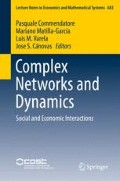Abstract
Real phenomena from different areas of Life Sciences can be described by complex networks, whose structure is usually determining their intrinsic dynamics. On the other hand, Dynamical Systems Theory is a powerful tool for the study of evolution processes in real situations. The concept of global attractor is the central one in this theory. In the last decades there has been an intensive research in the geometrical characterization of global attractors. However, there still exists a weak connection between the asymptotic dynamics of a complex network and the structure of associated global attractors. In this paper we show that, in order to analyze the long-time behavior of the dynamics on a complex network, it is the topological and geometrical structure of the attractor the subject to take into account. In fact, given a complex network, a global attractor can be understood as the new attracting complex network which is really describing and determining the forwards dynamics of the phenomena. We illustrate our discussion with models of differential equations related to mutualistic complex networks in Economy and Ecology.
Access this chapter
Tax calculation will be finalised at checkout
Purchases are for personal use only
References
Allesina S, Tang S (2012) Stability criteria for complex ecosystems. Nature 483:205–208
Aragão-Costa ER, Caraballo T, Carvalho AN, Langa JA (2011) Stability of gradient semigroups under perturbation. Nonlinearity 24:2099–2117
Aragão-Costa ER, Caraballo T, Carvalho AN, Langa JA (2012) Continuity of Lyapunov functions and of energy level for a generalized gradient system. Topol Methods Nonlinear Anal 39:57–82
Arrieta J, Carvalho AN, Langa JA, Rodríguez-Bernal A (2012) Continuity of dynamical structures for non-autonomous evolution equations under singular perturbations. J Dyn Diff Equat 24:427–481
Babin AV, Vishik M (1983) Regular attractors of semigroups and evolution equations. J Math Pures Appl 62:441–491
Babin AV, Vishik MI (1992) Attractors of evolution equations. North Holland, Amsterdam
Bascompte J, Jordano P (2007) The structure of plant-animal mutualistic networks: the architecture of biodiversity. Annu Rev Ecol Evol Syst 38:567–593
Bascompte J, Jordano P, Melián CJ, Olesen JM (2003) The nested assembly of plant-animal mutualistic networks. Proc Natl Acad Sci USA 100:9383–9387
Bascompte J, Jordano P, Olesen JM (2006) Asymmetric coevolutionary networks facilitate biodiversity maintenance. Science 312:431–433
Bastolla U, Fortuna MA, Pascual-García A, Ferrera A, Luque B, Bascompte J (2009) The architecture of mutualistic networks minimizes competition and increases biodiversity. Nature 458:1018–1020
Carvalho AN, Langa JA (2009) An extension of the concept of gradient semigroups which is stable under perturbation. J Differ Equ 246:2646–2668
Carvalho AN, Langa JA, Robinson JC, Suárez A (2007) Characterization of non-autonomous attractors of a perturbed gradient system. J Differ Equ 236:570–603
Carvalho AN, Langa JA, Robinson JC (2013) Attractors for infinite-dimensional non-autonomous dynamical systems. Applied mathematical series, vol 182. Springer, New York
Carvalho AN, Langa JA, Robinson JC (2015) Non-autonomous dynamical systems. Discret Cont Dyn Syst B 20:703–747
Conley C (1978) Isolated invariant sets and the Morse index. CBMS regional conference series in mathematics, vol 38. American Mathematical Society, Providence, RI
Guerrero G, Langa JA, Suárez A (2014) Biodiversity and vulnerability in a 3D mutualistic system. Discret Cont Dyn Syst 34:4107–4126
Guerrero G, Langa JA, Suárez A (2015) Architecture of attractor determines dynamics on mutualistic complex networks. Preprint
Hale JK (1988) Asymptotic behavior of dissipative systems. Mathematical surveys and monographs. American Mathematical Society, Providence, RI
Hale JK, Magalhães LT, Oliva WM (1984) An introduction to infinite-dimensional dynamical systems - geometric theory. Applied mathematical sciences, vol 47. Springer, Berlin
Henry D (1981) Geometric theory of semilinear parabolic equations. Lecture notes in mathematics, vol 840. Springer, Berlin
Ladyzhenskaya OA (1991) Attractors for semigroups and evolution equations. Cambridge University Press, Cambridge
Okuyama T, Holland JN (2008) Network structural properties mediate the stability of mutualistic communities. Ecol Lett 11:208–216
Robinson JC (2001) Infinite-dimensional dynamical systems. Cambridge University Press, Cambridge
Rohr RP, Saavedra S, Bascompte J (2014) On the structural stability of mutualistic systems. Science 345:1–9
Rybakowski KP (1987) The homotopy index and partial differential equations. Springer, Berlin
Saavedra S, Reed-Tsochas F, Uzzi B (2009a) A simple model of bipartite cooperation for ecological and organisational networks. Nature 457:463–466
Saavedra S, Reed-Tsochas F, Uzzi B (2009b) Asymmetric disassembly and robustness in declining networks. Proc Natl Acad Sci USA 10:16466–16471
Saavedra S, Stouffer DB, Uzzi B, Bascompte J (2011) Strong contributors to network persistence are the most vulnerable to extinction. Nature 478:233–235
Sell GR, You Y (2002) Dynamics of evolutionary equations. Applied mathematical sciences, vol 143. Springer, New York
Suweis S, Simini F, Banavar JR, Maritan A (2013) Emergence of structural and dynamical properties of ecological mutualistic networks. Nature 500:449–452
Takeuchi Y (1996) Global dynamical properties of Lotka-Volterra systems. World Scientific, River Edge, NJ
Temam R (1988) Infinite-dimensional dynamical systems in mechanics and physics. Springer, Berlin
Thébault E, Fontaine C (2010) Stability of ecological communities and the architecture of mutualistic and trophic networks. Science 329:853–856
Vishik MI (1992) Asymptotic behaviour of solutions of evolutionary equations. Cambridge University Press, Cambridge
Acknowledgements
J.A. Langa is partially supported by FEDER and Ministerio de Economía y Competitividad grant # MTM2015-63723-P, Junta de Andalucía under Proyecto de Excelencia FQM-1492 and Brazilian-European partnership in Dynamical Systems (BREUDS) from the FP7-IRSES grant of the European Union.
A. Suárez is partially supported by FEDER and Ministerio de Economía y Competitividad grant # MTM2012-31304. This Chapter is based upon work from COST Action ISCH COST Action IS1104 “The EU in the new complex geography of economic systems: models, tools and policy evaluation”, supported by COST (European Cooperation in Science and Technology) www.cost.eu.
Author information
Authors and Affiliations
Corresponding author
Editor information
Editors and Affiliations
Rights and permissions
Copyright information
© 2016 Springer International Publishing Switzerland
About this chapter
Cite this chapter
Guerrero, G., Langa, J.A., Suárez, A. (2016). Attracting Complex Networks. In: Commendatore, P., Matilla-García, M., Varela, L., Cánovas, J. (eds) Complex Networks and Dynamics. Lecture Notes in Economics and Mathematical Systems, vol 683. Springer, Cham. https://doi.org/10.1007/978-3-319-40803-3_12
Download citation
DOI: https://doi.org/10.1007/978-3-319-40803-3_12
Published:
Publisher Name: Springer, Cham
Print ISBN: 978-3-319-40801-9
Online ISBN: 978-3-319-40803-3
eBook Packages: Economics and FinanceEconomics and Finance (R0)

